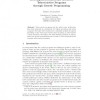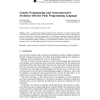1133 search results - page 18 / 227 » Backward-chaining genetic programming |
GPEM
2002
13 years 7 months ago
2002
A representation-less model for genetic programming is presented. The model is intended to examine the mechanisms that lead to bloat in genetic programming (GP). We discuss two hyp...
AIIA
1995
Springer
13 years 11 months ago
1995
Springer
Genetic Programming (GP) is a method of automatically inducing programs by representing them as parse trees. In theory, programs in any computer languages can be translated to par...
PRICAI
2004
Springer
14 years 23 days ago
2004
Springer
Abstract. A successful case of applying brute-force search to functional programming automation is presented and compared with a conventional genetic programming method. From the i...
EUROGP
2003
Springer
14 years 19 days ago
2003
Springer
Teleo-reactive programs and the triple tower architecture have been proposed as a framework for linking perception and action in agents. The triple tower architecture continually u...
GPEM
2002
13 years 7 months ago
2002
Push is a programming language designed for the expression of evolving programs within an evolutionary computation system. This article describes Push and illustrates some of the o...


